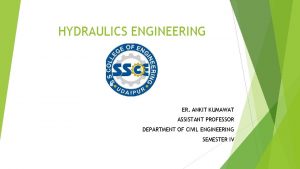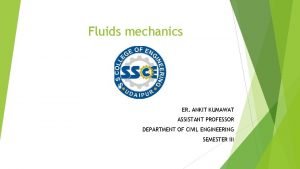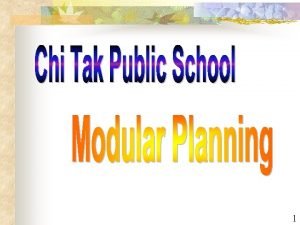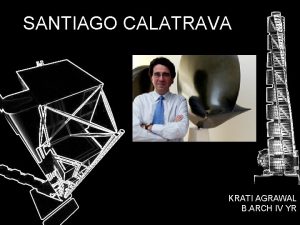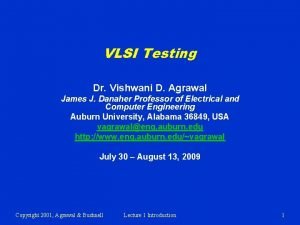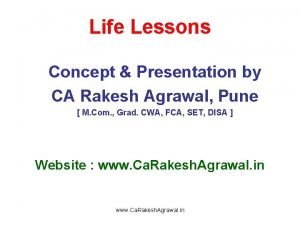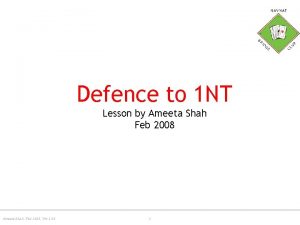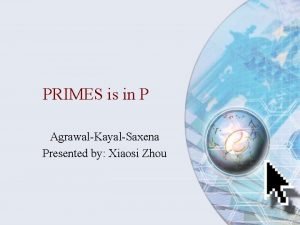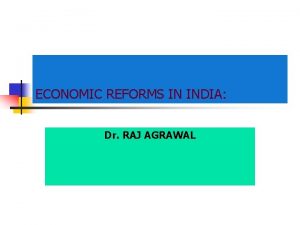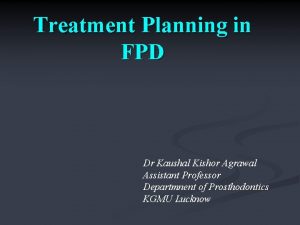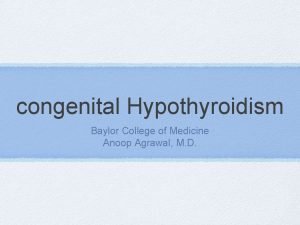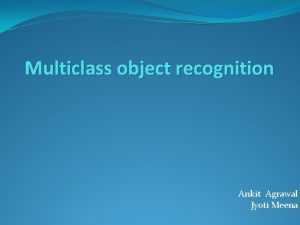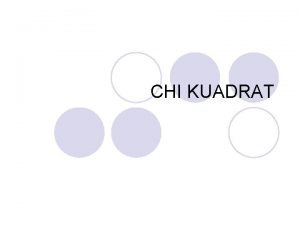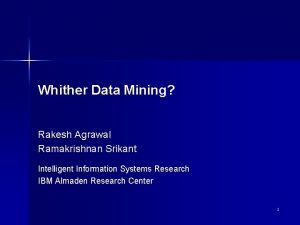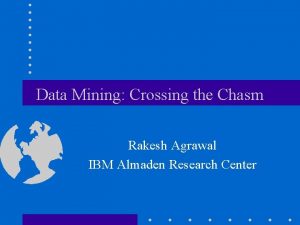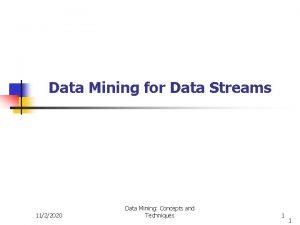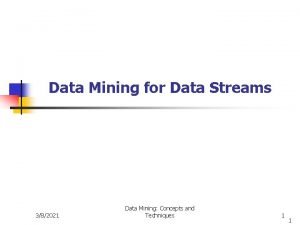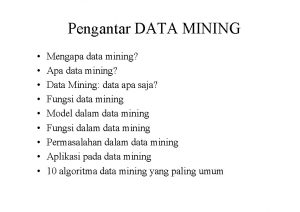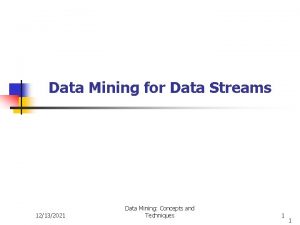CHi Ma D Data Mining Ankit Agrawal and





























- Slides: 29

CHi. Ma. D Data Mining Ankit Agrawal and Alok Choudhary Dept. of Electrical Engineering and Computer Science Northwestern University Team Members: Greg Olson, Chris Wolverton, Wei Chen, Cate Brinson Wei Xiong, Logan Ward, Vinay Hegde, Kareem Youssef, Yichi Zhang, He Zhao Amar Krishna, Ruoqian Liu, Arindam Paul, Alona Furmanchuk CHi. Ma. D Annual Meeting March 23, 2016

USE-CASE GROUP A. CHOUDHARY, A. AGRAWAL, NU DATA MINING GOALS Developing data-driven informatics to accelerate materials discovery and design Extracting actionable insights at unprecedented latency via bottom-up and hypothesis-driven discoveries Data mining on various heterogeneous and big databases that are complex, high dimensional, structured and semi-structured Research Accomplishments and Ongoing Efforts • Integrating CALPHAD and Data Mining for Advanced Steel Design • Composition-based Machine Learning Framework for Predicting Inorganic Material Properties • Supervised Learning-based Microstructure Characterization and Reconstruction • Fast Models for Properties of Crystalline Compounds Using Voronoi Tessellations and Machine Learning • Classification of Scientific Journal Articles to Support NIST Data Curation Efforts • Towards Designing OPV devices using Data Mining

Ongoing Projects • Integrating CALPHAD and Data Mining for Advanced Steel Design • Composition-based Machine Learning Framework for Predicting Inorganic Material Properties • Fast Models for Properties of Crystalline Compounds Using Voronoi Tessellations and Machine Learning • Supervised Learning-based Microstructure Characterization and Reconstruction • Classification of Scientific Journal Articles to Support NIST Data Curation Efforts • Towards Designing OPV devices using Data Mining 2

Ongoing Projects • Integrating CALPHAD and Data Mining for Advanced Steel Design • Composition-based Machine Learning Framework for Predicting Inorganic Material Properties • Fast Models for Properties of Crystalline Compounds Using Voronoi Tessellations and Machine Learning • Supervised Learning-based Microstructure Characterization and Reconstruction • Classification of Scientific Journal Articles to Support NIST Data Curation Efforts • Towards Designing OPV devices using Data Mining 3

Prior Work: Steel Fatigue Strength Prediction COMPOSITION NIMS experimental database • CORRELATES TO MANUFACTURING • CORRELATES TO PROCESSES PROPERTIES (FATIGUE STRENGTH) A. Agrawal, P. D. Deshpande, A. Cecen, G. P. Basavarsu, A. N. Choudhary, and S. R. Kalidindi, “Exploration of data science techniques to predict fatigue strength of steel from composition and processing parameters, ” Integrating Materials and Manufacturing Innovation, 3 (8): 1– 19, 2014.

Envisioned Integration of CALPHAD and Data Mining Contributors: Ankit Agrawal, Wei Xiong, Greg Olson, Alok Choudhary NIMS steel database TQ interface / Thermo-Calc Martensitic theory CALPHAD model Thermodynamic info Volume fraction of Carbide Volume fraction of Oxide Martensitic temperature Residual austenite fraction Austenite stability Structure. Property Linkages (More applicable than prior models)

Experimental database on Fatigue Strength of carbon steels from NIMS, Japan 0. 17~0. 63 0. 16~2. 05 0. 37~1. 60 0. 00~0. 03 0. 01~2. 78 0. 01~1. 17 0. 01~0. 26 0. 00~0. 24 NIMS experimental database for 10 component system 1. 2. 3. 4. 5. 6. 7. Normalizing temp / time Quenching temp / time Hardening temp / time Carburization temp / time Diffusion temp / time Composition (9 element) Inclusion, vol. % Rotating bending fatigue strength (107 Cycles) High cycle fatigue testing 6

Advantage of coupling CALPHAD with data-mining Fe, C, Cr, Al, Ni Experimental information CALPHAD Fe, C, Cr, Al, Ni, Co, Mn, etc. Experimental information Attributes of Phases Data-mining Attributes of Phases: • Ms temperature • Inclusion volume fraction • Gibbs free energy • Austenite stability • Diffusivity • …… Fatigue Model

Coupling between CALPHAD and data-mining Data-mining Method 2 1. 2. • • • Martensitic transformation theoretical models Phase diagram theoretical models Carbide, vol. % Ms temperature Retained Austensite Fraction Inclusion, vol. % (same as experiment) Austenite stability parameter Fatigue strength Level 2 (model) Method 1 Level 1 (Input/Experiment) Method 2 Using Thermo-Calc/TQ toolbox, an interface has been built to convert level 1 raw data into thermodynamic key parameters (Level 2) 1. 2. 3. 4. 5. 6. 7. Normalizing temp / time Quenching temp / time Hardening temp / time Carburization temp / time Diffusion temp / time Composition (9 element) Inclusion, vol. % 8

Level 2 / Model / Thermo-Calc TQ interface Five parameters for primary consideration: 1. Oxide vol. % (experiment: 0. 008~0. 15%) 2. Carbide content (Thermo-Calc database) 3. Ms temperature 4. Retained Austenite Concentration Ref: D. P. Koistinen and R. F. Marburger, Acta Metall. 7 (1959) 59 -60. 5. Austenite stability parameter Ref: G. Ghosh and G. B. Olson, Acta Metall. Mater. , 42 (1994) 3361 -3370. 9

Preliminary Results: Attribute Ranking Ms temperature is the most important parameter in datamining 10

Existing Models for Ms Temperature Comparison of Ms temperature between new and old datasets 700 Model B: Ref: Capdevila, et al. , ISIJ International 42 (2002) 894 680 Ms, Model A 660 640 620 600 580 Model A: Ref: Stormvinter et al. , MMTA 43 (2012) 3870 560 540 520 500 520 540 560 580 600 620 640 660 680 700 Ms, Model B • Model B is generated using model based on 748 experimental data points for Ms temperature, It should be more accurate than Model A.

Existing Models for Ms Temperature R 2=0. 5749 R 2=0. 6847 14

Predictive Modeling for Ms Temperature Preprocessin g Experimental Data on Martensitic temperature Predictive modeling Ms Temperature Prediction Database Evaluation Testing split Training split

Data Mining Models for Ms Temperature R 2=0. 7812 R 2=0. 8437 R 2=0. 7853 R 2=0. 8634 R 2=0. 9166 R 2=0. 9087

M 5 P Decision Tree Model for Ms Temperature … 17

Predictive Models for Ms Temperature R R 2 MAE RMSE MAEf Model A 0. 7582 0. 5749 51. 62 94. 83 0. 1060 Model B Linear Regression Neural Networks Support Vector Machines Nearest Neighbor Decision Tree (M 5 P) 0. 8275 0. 6847 37. 24 69. 83 0. 0816 0. 8839 0. 7812 33. 85 55. 97 0. 0749 0. 9185 0. 8437 23. 78 47. 77 0. 0474 0. 8862 0. 7853 30. 43 55. 93 0. 0709 0. 9292 0. 8634 27. 73 44. 55 0. 0553 0. 9574 0. 9166 20. 83 34. 45 0. 0430 Random Forest 0. 9533 0. 9087 22. 92 36. 65 0. 0474 18

Predictive Modeling for Fatigue Strength CALPHAD Experimental Data from NIMS Ms. T predictor Predictive modeling Fatigue Strength Prediction Database Evaluation Testing split Training split

Predictive Models for Fatigue Strength R 2=0. 5462 R 2=0. 8688 R 2=0. 5176 R 2=0. 9251 R 2=0. 8823 R 2=0. 9308

Predictive Models for Fatigue Strength R R 2 MAE RMSE MAEf 0. 7391 0. 5462 85. 06 125. 70 0. 1606 0. 9321 0. 8688 51. 13 67. 55 0. 0973 0. 7194 0. 5176 79. 68 131. 49 0. 1392 0. 9618 0. 9251 45. 17 51. 09 0. 0857 Decision Table Decision Tree (M 5 P) Decision Tree (Random Tree) Decision Tree (REPTree) 0. 9420 0. 8874 47. 03 62. 60 0. 0857 0. 9393 0. 8823 49. 32 66. 66 0. 0952 0. 9566 0. 9151 45. 64 54. 58 0. 0861 0. 9453 0. 8936 42. 16 61. 13 0. 0844 Random Forest 0. 9648 0. 9308 40. 92 49. 17 0. 0808 Linear Regression Neural Networks Support Vector Machines Nearest Neighbor 21

Future Directions • Improving Processing-Structure linkage – Use better martensitic theory models – More accurate oxide fraction, austenite stability parameter • Improving Structure-Property linkage – Use ensemble data mining models – Explore hierarchical predictive mining • Get access to more experimental data? • Inverse models (property-structure-processing) for steel design • Long-term vision: Verification with experiments

Ongoing Projects • Integrating CALPHAD and Data Mining for Advanced Steel Design • Composition-based Machine Learning Framework for Predicting Inorganic Material Properties • Fast Models for Properties of Crystalline Compounds Using Voronoi Tessellations and Machine Learning • Supervised Learning-based Microstructure Characterization and Reconstruction • Classification of Scientific Journal Articles to Support NIST Data Curation Efforts • Towards Designing OPV devices using Data Mining 23

A General-Purpose Machine Learning Framework for Linking Composition and Properties Contributors: Logan Ward, Rosanne Liu, Kareem Youssef Ankit Agrawal, Alok Choudhary, Chris Wolverton Goal: Simplify the creation of machine learning models Strategy: 1. General purpose representations 2. User-friendly software GFA Using Experimental Data Measured Predicted

Fast Models for Properties of Crystalline Compounds Using Voronoi Tessellations and Machine Learning Contributors: Rosanne Liu, Logan Ward, Amar Krishna, Vinay Hedge, Chris Wolverton, Ankit Agrawal, Alok Choudhary Goal: Incorporate crystal structure information into models Method: Use local environment determined using Voronoi tessellation Application: Replace / reduce DFT calculations Example: Predicting formation energy

Structural Equation Model for Key Descriptor Identification Contributors: Yichi Zhang, He Zhao, Cate Brinson, Wei Chen • Reduce dimension by discovering latent microstructure features Feature Selection (Choose important descriptors by weights) Feature extraction (Create latent factors) Input data: Microstructure Descriptors Exploratory Factor Analysis (EFA) Grouping & reduction of descriptors Input: Descriptor X 1 X 2 Response data: Correlation functions /Properties X 3 SEM Parameter Estimation X 4 F 1 Responses: Property Y 1 F’ 1 Y 2 F 2 Y 3 F’ 2 F 3 Y 4 X 5 Data Latent Features SEM based analysis Zhang, Y. , Zhao, H. , et al. , 2015, TMS IMMI Output

Classification of Scientific Journal Articles to Support NIST Data Curation Efforts Contributors: Amar Krishna, Sarala Padi, Adele Peskin, Ankit Agrawal, Alden Dima, Ken Kroenlein, Alok Choudhary Ø Goal: Automating the TRC’s document classification and curation process. Ø Methodology: Topic Modeling followed by Classification Ø Dataset: 2357 articles dataset with 1000 topics (for each article). Ø Results: 10 -fold crossvalidation classification accuracy of 0. 95 (Area under the ROC curve) Web Tool: http: //info. eecs. northwestern. edu/TRCArticle. Classifier/

Designing optimal OPV devices by modeling Processing. Structure-Property Linkages using Machine Learning Contributors: Arindam Paul, Alona Furmanchuk, Logan Ward, Chris Wolverton, Ankit Agrawal, Alok Choudhary Goal: Develop a system using ML to predict devices with optimal PCE (power conversion efficiency) Strategy: 1. Fingerprints 2. Schema based on literature to describe OPV devices 3. Processing TEM images of active layer to derive descriptors Chemical Formula, Fingerprints Build models using algorithms Iterate for best prediction Predict Real Data

Online predictive tools for thermoelectric non-stoichiometric materials Contributors: Al’ona Furmanchuk, Ankit Agrawal, James Saal, Jeff W. Doak, Gregory B. Olson, Alok Choudhary http: //info. eecs. northwestern. edu/Thermo. El Electrical conductivity Thermoelectric figure-of-merit Seebeck coefficient Temperature Thermal conductivity

Thank You ! Ankit Agrawal Research Associate Professor Dept. of Electrical Engineering and Computer Science Northwestern University ankitag@eecs. northwestern. edu www. eecs. northwestern. edu/~ankitag/ 30
 Eck
Eck Ankit saxena
Ankit saxena Ankit agarwal coinbase
Ankit agarwal coinbase Hydraulic engineering
Hydraulic engineering Ankit kumawat
Ankit kumawat Define sreyas
Define sreyas Multimedia data mining
Multimedia data mining Difference between strip mining and open pit mining
Difference between strip mining and open pit mining Web text mining
Web text mining đổi địa chỉ logic sang địa chỉ vật lý
đổi địa chỉ logic sang địa chỉ vật lý Chi chi does nnn
Chi chi does nnn Chi chi tg tf
Chi chi tg tf Chi domanda lavoro
Chi domanda lavoro Dr deepak agrawal
Dr deepak agrawal Krati agrawal
Krati agrawal Subodh agrawal
Subodh agrawal Vishwani agrawal
Vishwani agrawal Ameeta agrawal
Ameeta agrawal Shankarlal agrawal science college salekasa
Shankarlal agrawal science college salekasa Ca rakesh agrawal
Ca rakesh agrawal Asptro
Asptro Agrawal-kayal-saxena
Agrawal-kayal-saxena Divyakant agrawal
Divyakant agrawal Shweta agrawal iit madras
Shweta agrawal iit madras Dr raj agrawal
Dr raj agrawal Dr kaushal agrawal
Dr kaushal agrawal Screw feed technology of waste management
Screw feed technology of waste management Anoop agrawal
Anoop agrawal What is data mining and data warehousing
What is data mining and data warehousing Data mining dan data warehouse
Data mining dan data warehouse



